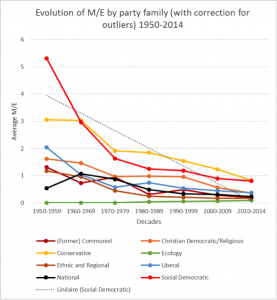Emilie van Haute, Université libre de Bruxelles
What is MAPP and what we do?
MAPP is a working group on Members and Activists of Political Parties. It brings together international scholars interested in the topics of party affiliation, membership and activism. Launched in May 2014, MAPP is also a 3-year research project aimed at ‘understanding the dynamics of party membership’, and funded by the Belgian Fonds national de la recherche scientifique (FRS-FNRS).
The project intends to look at party affiliation as a relationship between supply and demand, between affiliates and their party organization, in a dynamic perspective. We realized that this relationship is not well understood. Too often, parties are considered as disincarnate organizations, or individual members are considered independent of the party they belong to. This is mainly due to the lack of available comparative data on the topic. The project intends to provide this comparative data.
How far are we?
As for Phase 1 (completed), we have undertaken a huge archival work. We have summarized what exists in terms of surveys of party members and activists, and we have archived the survey questionnaires and/or data. It has also lead to the publication of an edited volume with Routledge (Van Haute E., Gauja A. (eds) (2015), Party Members and Activists. London: Routledge). The volume summarizes where we stand and what we know about membership and activism today. It provides a clear picture of who joins political parties, why they do it, the character of their political activism, how they engage with their parties, and what opinion they hold.
Also, we have gathered longitudinal data on party membership for no less than 397 parties in 31 countries. These data allow going beyond national aggregates of party membership. It also allows testing for alternative explanations of party membership fluctuations over time, beyond the traditional macro- and micro-level perspectives. Particularly, party level explanations can be investigated, which will allow to test whether parties can do anything about these fluctuations or whether they are powerless towards their membership levels.
For example, we have calculated the ratios of members/voting age population (M/E) for each party. The figure below displays the average ratios by party family per decade since 1950 (see the figure below, click to enlarge). Significant differences appear. While a general declining trend of party membership is clearly observable, some party families seem to have coped slightly better than others. Indeed, the Conservatives display a lower rate of decline than the Social Democrats. Furthermore, the membership decline among the Social Democrats has slowed down in the last decades. Other party families such as the Christian Democrats and Liberals have faced a slower, non-linear decline, while the Greens have increased their average M/E in the last decades.
All these data are available on the project website.
What’s next?
Phases 2 and 3 of the MAPP project are based on a comparative analysis of parliamentary parties in 10 countries where experts have previous successful experiences with (online) surveys of party members. The data collection will comprise a local branch survey on the recruitment, management, and retention of party affiliates, as well as a survey of party affiliates (members and, where applicable, supporters). These surveys will allow to better grasp the dynamics of party affiliation, understood as a relation between affiliates and their party.

